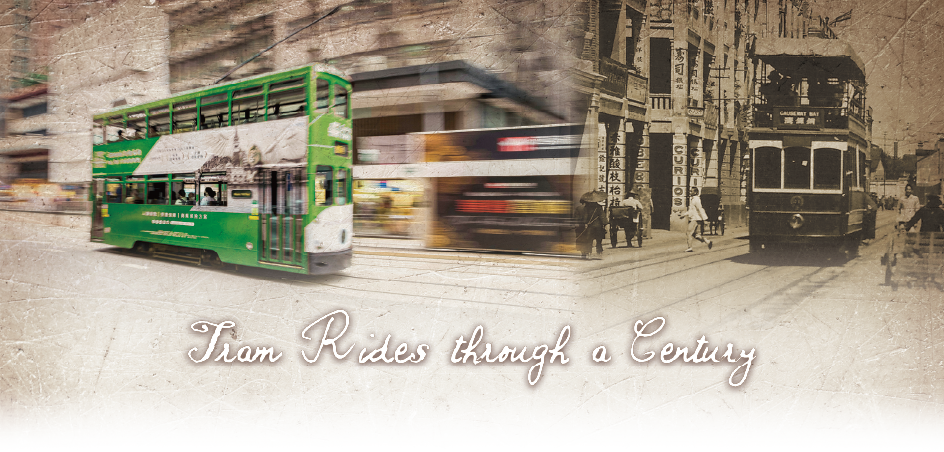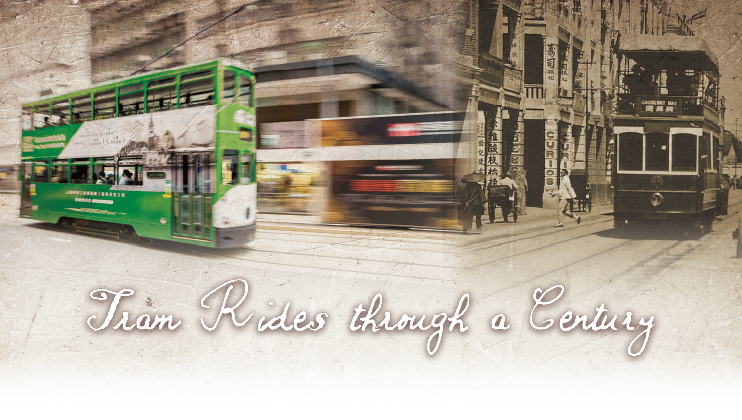

Affectionately called “Ding Dings” by locals, trams are perhaps the most iconic means of transport in Hong Kong. Hopping on and off, riders can conveniently travel along the northern shore of the island and explore interesting places at their own pace. While the 13-kilometre tram route from Kennedy Town to Shau Kei Wan remains virtually unchanged, the cityscape along it has undergone dramatic transformation over the past century.
Exactly one hundred years ago, fully enclosed double-decker tramcars came into service. Tickets were sold and punched by conductors on board: five cents for a lower deck seat and ten cents for one on the upper deck with better views. Trundling along with passengers on board, trams then shared the road with girls in wooden clogs, old men with carrying poles, handcarts, and the occasional automobiles.
An east-bound ride started at the Kennedy Town Terminus. Trams rolled past on Praya, Kennedy Town, passing warehouses and factories on one side and junks in the harbour on the other. The air smelt wet, salty, and dirty. Passengers were then greeted by a bustling cluster of cargo piers, cramped tenement houses and dried seafood shops in Sheung Wan. The vibrancy of this place was vividly captured in the myriad of sounds in the background: shouts from coolies unloading cargo ships, the clinking of frying shovels from chestnut vendors, and the clattering of mahjong tiles.
Central, the heart of Victoria City, has long been home to luxurious hotels and prestigious banks. Riding along Des Voeux Road Central, passengers would marvel at the splendid sights of the Hongkong Hotel and Alexandra Building. Outside the General Post Office, rickshaw pullers and sedan chair carriers lined up for potential passengers. Though their services were immediately available, the tram was still the preferred mode for long haul due to shorter travelling time.
After passing through the densely populated Wan Chai district, passengers would note that there was much less hustle and bustle in Causeway Bay and North Point. With landscape and townscape including a typhoon shelter, scattered low-rise tenement blocks and emerald hills, the areas looked laid back and relaxed. Further down the tramway line were Taikoo Sugar Refinery and Taikoo Dockyard in Quarry Bay, the backbone of the city’s industry in the pre-war years, and finally Shau Kei Wan, a fishing village. Looking further, one would see hundreds of sampans and fishing boats berthed at Aldrich Bay in the last glow of sunset.
A hundred years have passed. Today, trams still depart from the Kennedy Town Terminus, but the area has taken on an entirely different vibe. Stylish apartment buildings, chic bistros and cosy cafes are abundant. Praya, ironically, is no longer by the waterfront. Views of the harbour are blocked by a futuristic public swimming pool, with the saltiness in the air replaced by the alluring aroma of coffee and croissants. In Sheung Wan, the days when people lived in dilapidated tenement buildings and coolies toiled in cargo piers are long gone. Dried seafood shops, however, still cling on and welcome every passerby with a nostalgic smell.
Now a maze of concrete, glass and steel, Central remains the financial hub of the city. Though some of the most stunning historic buildings have been demolished, tram riders can today look up at the magnificent skyscrapers such as the International Finance Centre and the Bank of China Building, and watch the reflections of tram bodies on the glass facades along the road.
As trams go further east, the urban fabric becomes more homogeneous, with Causeway Bay and North Point dominated by a mix of residential and commercial buildings. The refinery and dockyard in Quarry Bay have long vanished into history owing to the dwindling significance of industry to the city. The land on which they once stood is now a forest of giant, glitzy office towers. Shau Kei Wan is no longer home for boat dwellers or fishermen but a built-up area for the ever-growing population. Similarly, Aldrich Bay has become a residential area after a major reclamation scheme.
“Ding Dings” have day after day rolled through the city for over a century, standing witness to its metamorphosis from a trading and fishing port to an international metropolis. An efficient means of transport in the past, trams are today slow when compared with other modes of transport. In this fast-paced modern world, however, there is something timeless and beautiful in the ringing bells of the tram and something comforting in the stop-and-go motion of its ride. Not only do trams keep alive fond memories of the past, they also reassure us that tomorrow is just another day.











